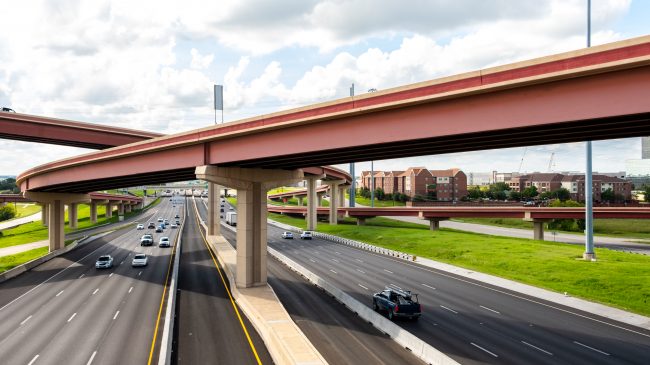Advocates of smart growth, meaning high-density housing served by transit, typically argue that adding highway capacity is futile because, they say, within a few years the new capacity fills up and the highway is just as congested as before. Some even refer to this assumption as the “iron law of freeway congestion.” Actually, this idea is highly debatable.
If the “iron law of freeway congestion” actually held true, then all freeway systems would be operating at seriously congested conditions. Yet, 35 years of annual data from the Texas Transportation Institute (TTI) at Texas A&M show that traffic congestion varies widely, even among the 15 largest metro areas in the United States. This is especially evident if we compare fast-growing metro areas like Atlanta and Houston with slower-growing areas like Detroit and Peoria.
Some capacity additions eliminate major bottlenecks in freeway systems. For example, consider an obsolete interchange designed 50 years ago for half the level of current travel. Milwaukee redesigned and rebuilt its Marquette interchange and experienced significant congestion relief. Other bottlenecks include places where a freeway decreases from three lanes each way to two lanes, which may have fit travel volumes from 30 years ago but is no longer adequate today.
Because adding lanes and replacing obsolete bridges and interchanges is very expensive, most metro areas tend to make only small capacity additions, which make only small reductions in congestion (and which might be overcome via several years of growth in population and travel). But when the means and motivation are there for larger expansions, the results can be impressive.
The Texas Transportation Institute studied how much capacity the 84 largest metro areas in the US had added over many years. TTI found that the 17 metro areas that did the best at expanding capacity to keep pace with travel growth actually reversed the upward trend in their congestion. By contrast, the other regions experienced worsening congestion as travel growth continued.
One dramatic example is Phoenix, which has been fast-growing since the 1950s but didn’t start developing its freeway system until the 1980s. Back in 1982, with only a single freeway (I-10 running through the center of the city), Phoenix had the fourth-highest annual delay per auto commuter in the nation). Thirty-five years later, with its population having grown from 1.4 million to 4 million in 2017 and with much of the area’s planned freeway system in place, Phoenix ranked 18th nationwide in delay per commuter. Phoenix’s congestion had increased somewhat, but it was far less congestion growth than in 17 other large metro areas that had pursued less highway capacity expansion.
Many studies cited by adherents to the iron law believe that a new freeway lane “induces” so many people to drive that the freeway soon fills up again. But this induced demand idea has been questioned by other researchers. One of the most-cited iron law studies is flawed. It measured only traffic on the expanded freeway, ignoring the fact that much of the new traffic on that freeway was by people who’d been making the same trip on a parallel boulevard. More careful assessments that take into account the whole roadway network find that perhaps 40 percent of additional travel on an expanded freeway is actually new trips and a lot of that is generated by economic development stimulated by the improved corridor.
Finally, and unfortunately, many induced-demand studies look only at the costs but not the benefits of adding highway capacity. Drivers who shift to the improved freeway do so only if it saves them travel time and possibly makes their trip times more reliable. Enabling people to have longer-distance commute trips that take the same amount of time opens up more job opportunities to individuals and offers companies a wider array of talent. Many studies find that this actually improves the economic productivity of a metro area. Moreover, travel on limited-access highways, such as freeways, is much safer than travel on surface streets.
Reason’s Debatable Ideas series examining transportation and infrastructure issues is available here.
Additional resources on induced demand and the law of freeway congestion:
Robert Poole, “Examining Claims About Induced Demand, Adding Road Capacity, and Traffic Congestion,” Reason Foundation, Aug. 19, 2019
Mark Kiefer and S. R. Mehndiratta, “If We Build It, Will They Really Keep Coming? A Critical Analysis of the Induced Demand Hypothesis,” Annual Meeting Preprint Paper 980937, Transportation Research Board, 1998
Robert Cervero, “Are Induced-Travel Studies Inducing Bad Investments?” Access Magazine, Spring 2003
Randal O’Toole, “The Induced-Demand Con,” The Antiplanner, March 17, 2020

